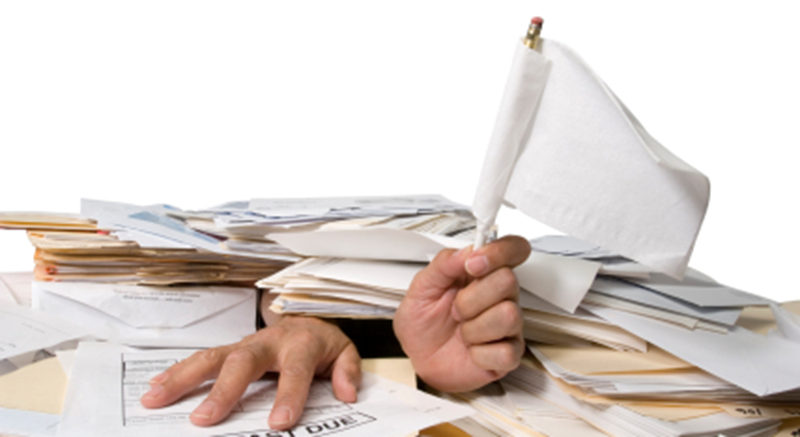This is the time of year that every office, home and business, needs a good clutter clean out. Clearing off your surfaces and cleaning out your drawers and files can boost your productivity and clear your head for the year to come. A few simple steps can give you that much-needed fresh start.
1. Desktop
The surface of your desk is your prime workspace. Clear off anything that isn’t used on a daily basis. If you find you’re reaching for something several times a day, it belongs on the desktop. If you’re pushing stuff aside to find something, or constantly searching for things in the piles, that stuff is just getting in your way. Get it off your desk, and find a home for it either in a drawer, in a file, or in the trash!
2. Desk drawers
If you could supply a small Staples store with the paper clips, pens, pads, rubber bands and other office supplies in your desk drawers, they’re probably overstuffed and not functioning efficiently. Keep in mind that office supplies exist to support your work, not get in the way of it! If you’re pawing through overstuffed drawers and you can’t find what you need when you need it on a regular basis, you need a thorough purge. Get rid of the dried-out pens, wrinkled envelopes, broken rubber bands and bent paper clips. Keep just enough to have what you need on hand in your desk and store the rest in a supply closet, or in bins or baskets on shelving above the desk or in another part of the room.
One more consideration: whenever you’re tempted to go out and buy more office supplies to “get organized”, resist, resist, resist! Go through what you have first. I’m often amazed at how much my clients have in the way of new, unused office supplies, because when they can’t find what they need right away in the clutter, they go out and buy more! Save yourself the effort and expense and go through what’s already there. You may be pleasantly surprised by what you already have!
3. Files
This is the tough stuff. Our homes and offices accumulate paper on a daily basis (the mail comes every day!) While keeping some of it is necessary, keeping all of it forever causes all kinds of problems. It fills up our spaces, gets in the way, and makes it difficult to find what we need when we need it. Shuffling through piles of paper searching for a needed document wastes time and causes frustration. When file drawers are packed full with out-of-date, obsolete paperwork, there’s no room for newer, more relevant documents. The piles on top of and around the filing cabinets grow, it becomes harder to find stuff, and your physical space becomes stifling and cluttered. Your productivity slows and your frustration grows!
If you haven’t purged your files in a long time, you may not be able to get through it all in one sitting. Take heart – one file drawer at a time over the course of several weeks will get you through the piles and lighten the load eventually.
4. What Do I Keep? 5 Questions
One question I’m repeatedly asked is, “what papers do I need to keep, and what can I let go?” In my experience, people keep far more than they need to, particularly in a home office setting. There are some helpful records retention guidelines online, and you should definitely check with your accountant and attorney for specific advice on what you need to keep. However, a good rule of thumb is that if it’s not tax-related (back-up documentation for a deduction, for example) it probably doesn’t need to be saved. And the papers that are truly significant (birth certificates, death certificates, passports, stock certificates, insurance policies, marriage licenses, divorce papers, car titles, etc.) should be saved in a VERY safe place, like a fireproof safe or a safe deposit box. Otherwise, if you’re struggling with what to keep, ask yourself 5 questions:
- Are there tax or legal reasons to keep it?
- Will it help me make money?
(ie: will it REALLY help me progress in my business?) - Is the information up to date?
- Can I find this information again in another place (ie: online)?
- What would be the worst possible thing that would happen if I let it go?
5. Let it Go – Thoughtfully!
Answering the above five questions honestly will really help you figure out what you need to keep and what can be tossed. And when you toss paperwork, be careful about how you let it go. Anything that has financial or medical information should be shredded. All the other stuff (articles you’ve printed out from online – actually almost ANYTHING you’ve printed out from online, except for financial and medical stuff – see above) can be tossed and/or recycled. If you’ve got a huge load to shred, calling a shredding company may cost you some bucks short term, but it’s really worth it in the long run. If you’ve got just a few boxes, places like Staples will shred your stuff for about $1 a pound. Totally worth the peace of mind. (Really – think about it – 25 pounds of paperwork = $25. Isn’t your peace of mind worth at least that?)
“The ability to simplify means to eliminate the unnecessary so that the necessary may speak.”
~ Hans Hoffman
Once you’ve purged the unnecessary from the necessary from your office, you will find that your mental clutter clears as well, and your productivity soars. If you’re struggling with getting your office in shape for the new year, please give me a call. Whether it’s hands-on or virtual assistance or helping to boost your team’s productivity, I’m happy to help, and anything related to your business is tax-deductible for the year!


